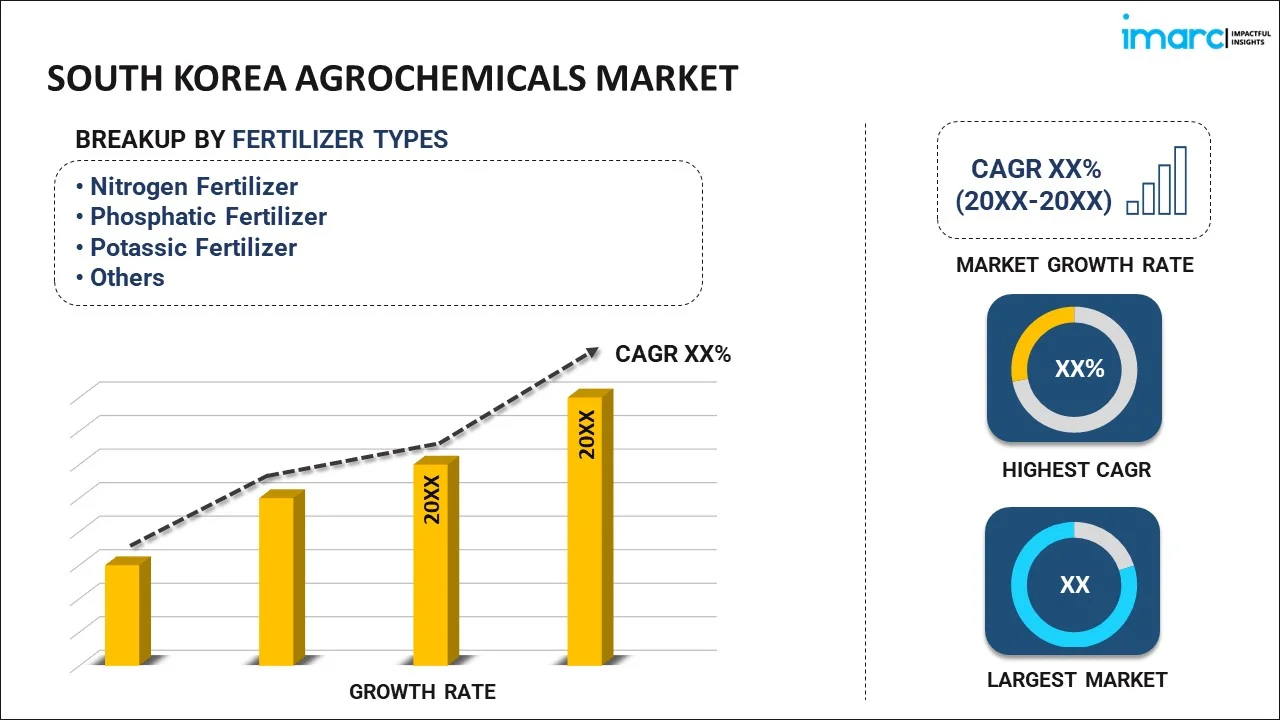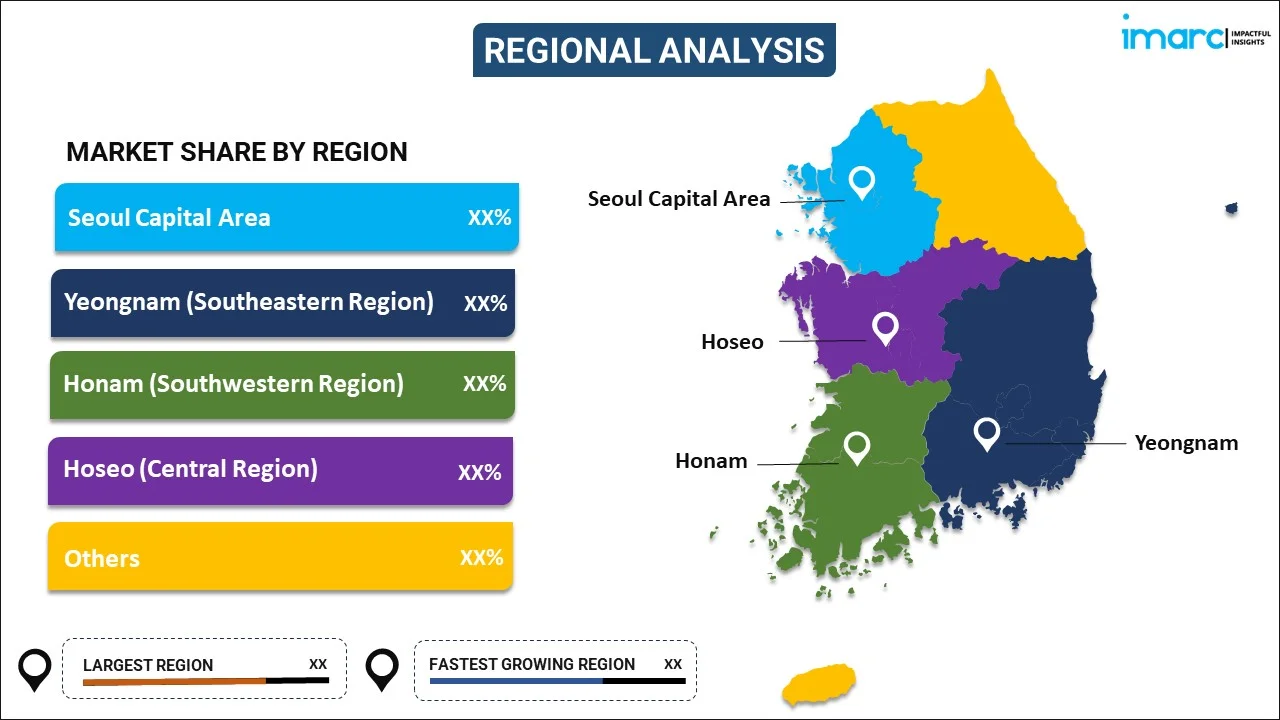
South Korea Agrochemicals Market Report by Fertilizer Type (Nitrogen Fertilizer, Phosphatic Fertilizer, Potassic Fertilizer, and Others), Pesticide Type (Fungicides, Herbicides, Insecticides, and Others), Crop Type (Cereals and Grains, Oilseeds and Pulses, Fruits and Vegetables, and Others), and Region 2025-2033
Market Overview:
South Korea agrochemicals market size reached USD 5,673.7 Million in 2024. Looking forward, IMARC Group expects the market to reach USD 8,301.8 Million by 2033, exhibiting a growth rate (CAGR) of 4.3% during 2025-2033. The increasing adoption of modern agricultural practices, including precision farming and the use of genetically modified crops, that can enhance the demand for agrochemicals, is driving the market.
|
Report Attribute
|
Key Statistics
|
|---|---|
|
Base Year
|
2024
|
|
Forecast Years
|
2025-2033
|
|
Historical Years
|
2019-2024
|
| Market Size in 2024 | USD 5,673.7 Million |
| Market Forecast in 2033 | USD 8,301.8 Million |
| Market Growth Rate 2025-2033 | 4.3% |
Agrochemicals are chemical substances used in agriculture to enhance crop productivity and protect plants from pests, diseases, and weeds. This diverse category includes fertilizers, pesticides, and herbicides. Fertilizers provide essential nutrients to plants, promoting growth and improving yield. Pesticides, such as insecticides and fungicides, safeguard crops by controlling and eliminating harmful pests and diseases. Herbicides target unwanted plants, preventing competition with cultivated crops. While agrochemicals have significantly contributed to increased agricultural efficiency and food production, their use raises environmental and health concerns. Runoff from fields can contaminate water sources, and pesticide residues may affect non-target organisms. Sustainable agriculture practices aim to minimize the negative impact of agrochemicals, promoting responsible and prudent use to balance agricultural productivity with environmental and human health considerations. Continuous R&D strives to enhance the effectiveness and safety of agrochemicals, fostering a more sustainable and resilient agricultural system.
South Korea Agrochemicals Market Trends:
The agrochemicals market in South Korea, fueled by several key drivers, has experienced significant growth over the past year. Firstly, the rising regional population necessitates increased agricultural productivity to meet food demands, propelling the demand for agrochemicals. Additionally, the ongoing trend of urbanization has led to shrinking arable land, prompting farmers to adopt advanced agricultural practices and rely on agrochemicals for efficient crop cultivation. Moreover, technological advancements in the agrochemical sector have introduced innovative formulations, enhancing the efficacy of pesticides, fertilizers, and herbicides. This has attracted farmers seeking sustainable and high-yield agricultural solutions, further boosting the agrochemicals market. Furthermore, the increasing awareness among farmers about the benefits of precision farming and integrated pest management has stimulated the adoption of agrochemicals. On the regulatory front, supportive government policies and initiatives promoting modern agricultural practices have contributed to the market's growth. Collaborative efforts between research institutions and agrochemical companies have also played a pivotal role in developing environmentally friendly and cost-effective solutions, aligning with the growing emphasis on sustainable agriculture. In conclusion, a confluence of factors, including population growth, urbanization, technological advancements, awareness, and regulatory support, continues to propel the upward trajectory of the agrochemicals market in South Korea.
South Korea Agrochemicals Market Segmentation:
IMARC Group provides an analysis of the key trends in each segment of the market, along with forecasts at the country level for 2025-2033. Our report has categorized the market based on fertilizer type, pesticide type, and crop type.
Fertilizer Type Insights:

- Nitrogen Fertilizer
- Phosphatic Fertilizer
- Potassic Fertilizer
- Others
The report has provided a detailed breakup and analysis of the market based on the fertilizer type. This includes nitrogen fertilizer, phosphatic fertilizer, potassic fertilizer, and others.
Pesticide Type Insights:
- Fungicides
- Herbicides
- Insecticides
- Others
A detailed breakup and analysis of the market based on the pesticide type have also been provided in the report. This includes fungicides, herbicides, insecticides, and others.
Crop Type Insights:
- Cereals and Grains
- Oilseeds and Pulses
- Fruits and Vegetables
- Others
The report has provided a detailed breakup and analysis of the market based on the crop type. This includes cereals and grains, oilseeds and pulses, fruits and vegetables, and others.
Regional Insights:

- Seoul Capital Area
- Yeongnam (Southeastern Region)
- Honam (Southwestern Region)
- Hoseo (Central Region)
- Others
The report has also provided a comprehensive analysis of all the major regional markets, which include Seoul Capital Area, Yeongnam (Southeastern Region), Honam (Southwestern Region), Hoseo (Central Region), and others.
Competitive Landscape:
The market research report has also provided a comprehensive analysis of the competitive landscape in the market. Competitive analysis such as market structure, key player positioning, top winning strategies, competitive dashboard, and company evaluation quadrant has been covered in the report. Also, detailed profiles of all major companies have been provided.
South Korea Agrochemicals Market Report Coverage:
| Report Features | Details |
|---|---|
| Base Year of the Analysis | 2024 |
| Historical Period | 2019-2024 |
| Forecast Period | 2025-2033 |
| Units | Million USD |
| Scope of the Report | Exploration of Historical Trends and Market Outlook, Industry Catalysts and Challenges, Segment-Wise Historical and Future Market Assessment:
|
| Fertilizer Types Covered | Nitrogen Fertilizer, Phosphatic Fertilizer, Potassic Fertilizer, Others |
| Pesticide Types Covered | Fungicides, Herbicides, Insecticides, Others |
| Crop Types Covered | Cereals and Grains, Oilseeds and Pulses, Fruits and Vegetables, Others |
| Regions Covered | Seoul Capital Area, Yeongnam (Southeastern Region), Honam (Southwestern Region), Hoseo (Central Region), Others |
| Customization Scope | 10% Free Customization |
| Post-Sale Analyst Support | 10-12 Weeks |
| Delivery Format | PDF and Excel through Email (We can also provide the editable version of the report in PPT/Word format on special request) |
Key Questions Answered in This Report:
- How has the South Korea agrochemicals market performed so far and how will it perform in the coming years?
- What has been the impact of COVID-19 on the South Korea agrochemicals market?
- What is the breakup of the South Korea agrochemicals market on the basis of fertilizer type?
- What is the breakup of the South Korea agrochemicals market on the basis of pesticide type?
- What is the breakup of the South Korea agrochemicals market on the basis of crop type?
- What are the various stages in the value chain of the South Korea agrochemicals market?
- What are the key driving factors and challenges in the South Korea agrochemicals?
- What is the structure of the South Korea agrochemicals market and who are the key players?
- What is the degree of competition in the South Korea agrochemicals market?
Key Benefits for Stakeholders:
- IMARC’s industry report offers a comprehensive quantitative analysis of various market segments, historical and current market trends, market forecasts, and dynamics of the South Korea agrochemicals market from 2019-2033.
- The research report provides the latest information on the market drivers, challenges, and opportunities in the South Korea agrochemicals market.
- Porter's five forces analysis assist stakeholders in assessing the impact of new entrants, competitive rivalry, supplier power, buyer power, and the threat of substitution. It helps stakeholders to analyze the level of competition within the South Korea agrochemicals industry and its attractiveness.
- Competitive landscape allows stakeholders to understand their competitive environment and provides an insight into the current positions of key players in the market.
Need more help?
- Speak to our experienced analysts for insights on the current market scenarios.
- Include additional segments and countries to customize the report as per your requirement.
- Gain an unparalleled competitive advantage in your domain by understanding how to utilize the report and positively impacting your operations and revenue.
- For further assistance, please connect with our analysts.
 Request Customization
Request Customization
 Speak to an Analyst
Speak to an Analyst
 Request Brochure
Request Brochure
 Inquire Before Buying
Inquire Before Buying




.webp)




.webp)












